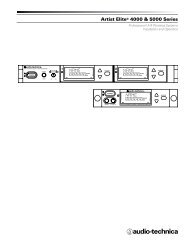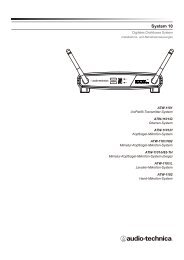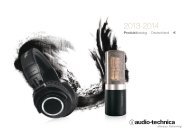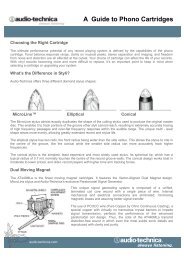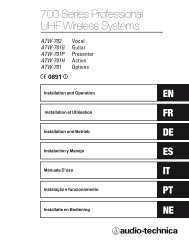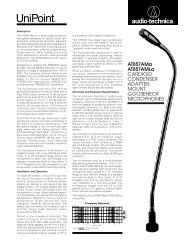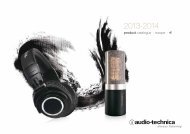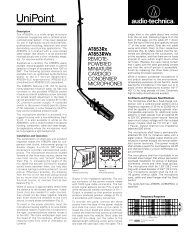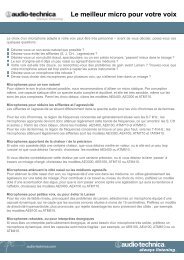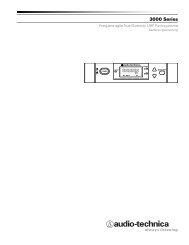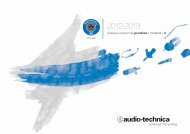ES933C Specification Sheet - Audio-Technica
ES933C Specification Sheet - Audio-Technica
ES933C Specification Sheet - Audio-Technica
You also want an ePaper? Increase the reach of your titles
YUMPU automatically turns print PDFs into web optimized ePapers that Google loves.
<strong>ES933C</strong><br />
CARDIOID CONDENSER<br />
HANGING MICROPHONE<br />
DESCRIPTION<br />
The <strong>ES933C</strong> is a wide-range miniature<br />
condenser microphone with a cardioid<br />
polar pattern. It is designed for quality<br />
sound reinforcement, professional<br />
recording, television and other<br />
demanding sound pickup applications.<br />
The <strong>ES933C</strong> is furnished with a vinylcoated<br />
steel hanger that allows it to be<br />
adjusted for correct positioning. An<br />
included snap-on foam windscreen<br />
effectively reduces noise from wind or<br />
ventilation air currents.<br />
The <strong>ES933C</strong> is equipped with<br />
UniGuard ® RFI-shielding technology,<br />
which offers outstanding rejection of<br />
radio frequency interference (RFI).<br />
The microphone is RoHS compliant –<br />
free from all substances specified in<br />
the EU directive on hazardous<br />
substances.<br />
mechanically coupled vibrations. To engage the UniSteep ®<br />
filter, use the end tip of a paperclip or other small pointed<br />
instrument to slide the switch toward the “bent” line.<br />
While a modern condenser microphone is not unduly sensitive<br />
to the environment, temperature extremes can be harmful.<br />
Avoid leaving the microphone in the open sun or in areas where<br />
temperatures exceed 110° F (43° C) for long periods of time.<br />
Extremely high humidity should also be avoided.<br />
NOTE: <strong>Audio</strong>-<strong>Technica</strong> has developed a special RFI-shielding<br />
mechanism that is an integral part of the connectors in the<br />
Engineered Sound line. If you remove or incorrectly replace the<br />
connector, you may adversely affect the unit's RFI immunity.<br />
<strong>Audio</strong>-<strong>Technica</strong> offers a crimp tool (ATCT) and RFI shields for<br />
TA3F-type, TA5F-type and XLRM-type connectors that enable you<br />
to shorten the cable and correctly reinstall the connector while<br />
maintaining the highest level of RFI immunity.<br />
DISTANCE “X”<br />
LESS THAN 2 TIMES “X”<br />
The microphone's cardioid polar<br />
pattern provides a 120° angle of<br />
acceptance. Additional interchangeable elements with omnidirectional<br />
(360°), hypercardioid (100°) and MicroLine ® (90°) pickup<br />
patterns are available.<br />
The microphone features a 50' (15.2 m) permanently attached<br />
miniature cable. Its free end connects to the provided AT8538<br />
power module via TA3F-type connector. It can be powered from<br />
any external 11V to 52V DC phantom power supply. A recessed<br />
switch in the power module permits choice of flat response or lowfrequency<br />
roll-off (via integral 80 Hz high-pass UniSteep ® filter) to<br />
help control undesired ambient noise.<br />
The microphone is enclosed in a rugged housing with a lowreflectance<br />
black finish. It is also available with white housing,<br />
cable and hanger as the ES933WC. The AT8538 power module is<br />
finished in black.<br />
INSTALLATION AND OPERATION<br />
The <strong>ES933C</strong> requires 11V to 52V phantom power for operation.<br />
The combination of small size and excellent response makes the<br />
<strong>ES933C</strong> ideal for suspension over choirs, instrumental groups or<br />
theater stages. A uniform 120° angle of acceptance provides wellbalanced<br />
audio pickup. The microphone should be located forward<br />
of the front-most source, above the rear-most source, and “aimed”<br />
between them (Fig. 1). Increasing the height of the mic above the<br />
sources will tend to equalize sound levels between them, but may<br />
also increase pickup of background or reverberant sound.<br />
Whenever possible, the distance from the mic to the rear-most<br />
source should be no more than twice the distance to the front<br />
source, to maintain front-to-rear balance (Fig. 1).<br />
Width of pickup is approximately three times the distance to the<br />
closest performer. If additional mics are needed for wide sources,<br />
they should be positioned apart laterally at least three times the<br />
distance to the front source, to avoid phase cancellation (Fig. 2).<br />
To orient the microphone in the proper direction, twist the housing<br />
slightly in its wire holder (clockwise rotation moves the microphone<br />
to the right; counterclockwise rotation moves it to the left).<br />
The provided foam windscreen simply snaps over the head of the<br />
microphone, effectively reducing noise from wind or ventilation air<br />
currents.<br />
Output is low impedance balanced. The output connector of the<br />
power module mates with XLRF-type cable connectors. The<br />
balanced signal appears across Pins 2 and 3, while the ground<br />
(shield) connection is Pin 1. Output is phased so that positive<br />
acoustic pressure produces positive voltage at Pin 2, in<br />
accordance with industry convention.<br />
120°<br />
ANGLE OF<br />
ACCEPTANCE<br />
Figure 1<br />
Figure 2<br />
ARCHITECTS AND ENGINEERS SPECIFICATIONS<br />
The microphone shall be a fixed-charge condenser designed for<br />
suspended installation in permanent or portable applications.<br />
It shall have a frequency response of 30 Hz to 20,000 Hz and a<br />
cardioid polar pattern with uniform 120° angle of acceptance. It<br />
shall be capable of accepting optional interchangeable elements<br />
for additional polar patterns. It shall be capable of handling sound<br />
input levels up to 138 dB with a dynamic range of 109 dB. Nominal<br />
open-circuit output voltage shall be 10.0 mV at 1 kHz, 1 Pascal.<br />
Output shall be low impedance balanced (250 ohms).<br />
The microphone shall operate from an external 11V to 52V DC<br />
phantom power source. It shall offer outstanding rejection of radio<br />
frequency interference (RFI). The microphone shall be RoHS compliant.<br />
The microphone shall have a permanently attached 50' (15.2 m)<br />
miniature low-noise cable. Its free end shall connect to a provided<br />
power module via TA3F-type connector. An optional crimping tool<br />
and crimp sleeves shall allow for shortening of the cable without<br />
loss of RFI immunity. The power module shall include a recessed<br />
switch for low-frequency roll-off. The low-frequency roll-off shall be<br />
a tailored roll-off at 80 Hz to minimize pickup of unwanted<br />
mechanical noise. Output from the power module shall terminate<br />
in a 3-pin XLRM-type output connector.<br />
For suspended installations, the microphone shall be provided<br />
with an adjustable steel wire hanger. The steel wire hanger shall<br />
attach to the microphone body and allow for the positioning of<br />
the microphone without the need for tools. Microphones using<br />
goosenecks or other methods for positioning shall be unacceptable.<br />
A snap-on foam windscreen shall be provided.<br />
The microphone shall be 1.08" (27.5 mm) long with a head diameter<br />
of 0.33" (8.4 mm). The microphone weight shall be 0.2 oz<br />
(5.5 grams) without cable. The microphone case, cable and steel<br />
hanger shall be finished in black [white]. The power module shall<br />
be finished in black.<br />
The <strong>Audio</strong>-<strong>Technica</strong> <strong>ES933C</strong> [ES933WC] is specified.<br />
120°<br />
MIC A<br />
MIC B<br />
3 TIMES<br />
DISTANCE “X”<br />
120°<br />
An integral 80 Hz high-pass UniSteep ® filter provides easy<br />
switching from a flat frequency response to a low-end roll-off. The<br />
roll-off position reduces the pickup of low-frequency ambient noise<br />
(such as traffic, air-handling systems, etc.), room reverberation and
8 kHz<br />
0.33"<br />
8.4 mm<br />
0.48"<br />
12.3 mm<br />
1.08"<br />
27.5 mm<br />
50'<br />
15.2 M<br />
0.13"<br />
3.2 mm<br />
0.74"<br />
18.9 mm<br />
3.66"<br />
92.9 mm<br />
<strong>ES933C</strong> SPECIFICATIONS †<br />
ELEMENT<br />
POLAR PATTERN<br />
FREQUENCY RESPONSE<br />
LOW-FREQUENCY ROLL-OFF<br />
OPEN CIRCUIT SENSITIVITY<br />
IMPEDANCE<br />
MAXIMUM INPUT SOUND LEVEL<br />
DYNAMIC RANGE (typical)<br />
SIGNAL-TO-NOISE RATIO 1<br />
SWITCH<br />
PHANTOM POWER<br />
REQUIREMENTS<br />
WEIGHT<br />
MICROPHONE<br />
POWER MODULE<br />
DIMENSIONS<br />
MICROPHONE<br />
POWER MODULE<br />
OUTPUT CONNECTOR<br />
(power module)<br />
CABLE<br />
Fixed-charge back plate<br />
permanently polarized condenser<br />
Cardioid<br />
30-20,000 Hz<br />
80 Hz, 18 dB/octave<br />
–40 dB (10.0 mV) re 1V at 1 Pa*<br />
250 ohms<br />
138 dB SPL, 1 kHz at 1% T.H.D.<br />
109 dB, 1 kHz at Max SPL<br />
65 dB, 1 kHz at 1 Pa*<br />
Flat, roll-off<br />
11-52V DC, 2 mA typical<br />
5.5 g (0.2 oz)<br />
81 g (2.9 oz)<br />
27.5 mm (1.08") long,<br />
8.4 mm (0.33") head diameter<br />
92.9 mm (3.66") long,<br />
18.9 mm (0.74") diameter<br />
Integral 3-pin XLRM-type<br />
15.2 m (50') long (permanently<br />
attached to microphone), 3.2 mm<br />
(0.13") diameter, 2-conductor<br />
shielded cable, terminated with<br />
TA3F-type connector<br />
OPTIONAL INTERCHANGEABLE ESE-O omnidirectional (360°);<br />
ELEMENTS ESE-H hypercardioid (100°);<br />
ESE-ML MicroLine ® (90°)<br />
ACCESSORIES FURNISHED<br />
<strong>ES933C</strong><br />
AT8109 two-stage foam<br />
windscreen; AT8452 steel hanger<br />
ES933WC<br />
AT8109(WH) two-stage foam<br />
windscreen; AT8452(WH) steel<br />
hanger<br />
Both<br />
AT8538 power module<br />
†In the interest of standards development, A.T.U.S. offers full details on its test<br />
methods to other industry professionals on request.<br />
*1 Pascal = 10 dynes/cm 2 = 10 microbars = 94 dB SPL<br />
1<br />
Typical, A-weighted, using <strong>Audio</strong> Precision System One.<br />
<strong>Specification</strong>s are subject to change without notice.<br />
Polar Pattern<br />
LEGEND<br />
SCALE IS 5 DECIBELS PER DIVISION<br />
200 Hz<br />
1 kHz<br />
5 kHz<br />
Frequency Response<br />
Response in dB<br />
Frequency in Hertz<br />
LEGEND<br />
12" or more on axis<br />
Roll-off<br />
<strong>Audio</strong>-<strong>Technica</strong> U.S., Inc., 1221 Commerce Drive, Stow, Ohio 44224<br />
<strong>Audio</strong>-<strong>Technica</strong> Limited, Old Lane, Leeds LS11 8AG England<br />
www.audio-technica.com<br />
P51925 ©2007 <strong>Audio</strong>-<strong>Technica</strong> U.S., Inc. Printed in U.S.A.




